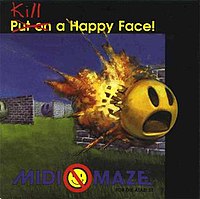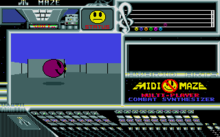MIDI Maze
This article needs additional citations for verification. (June 2021) |
| MIDI Maze | |
|---|---|
 Cover art | |
| Developer(s) | Xanth Software F/X |
| Publisher(s) | Hybrid Arts (ST) Bullet-Proof Software (GB, SNES) Riverhillsoft (PC, GG) |
| Platform(s) | Atari ST, Game Boy, Game Gear, SNES, Super CD-ROM² |
| Release | Atari ST
|
| Genre(s) | First-person shooter Maze |
| Mode(s) | Multiplayer |
MIDI Maze, also known as Faceball 2000, is a networked first-person shooter maze game for the Atari ST developed by Xanth Software F/X and released in 1987 by Hybrid Arts. The game takes place in a maze of untextured walls. The world animates smoothly as the player turns, much like the earlier Wayout, instead of only permitting 90 degree changes of direction. Using the MIDI ports on the Atari ST, the game is said to have introduced deathmatch combat to gaming in 1987. It also predated the LAN party concept by several years. The game found a wider audience when it was converted to Faceball 2000 on the Game Boy.
Gameplay
[edit]
Up to 16 computers can be networked in a "MIDI Ring" by daisy chaining MIDI ports that are built into the Atari ST series.
The game area occupies only roughly a quarter of the screen and consists of a first-person view of a flat-shaded maze with a crosshair in the middle. All players are shown as Pac-Man-like smiley avatars in various colors.[1][2] Bullets are represented as small spheres.
The game is started by a designated master machine, which sets rules, divides players into teams, and selects a maze. A number of mazes come with the game, and additional mazes can be constructed using a text-editor.
Development
[edit]The original MIDI Maze team at Xanth Software F/X consisted of James Yee as the business manager, Michael Park as the graphic and networking programmer, and George Miller writing the AI and drone logic.[citation needed]
Ports
[edit]A Game Boy version was developed by Xanth, and published in 1991 by Bullet-Proof Software, with the title Faceball 2000.[3] James Yee, owner of Xanth, had the idea of porting the 520ST application to the Game Boy. George Miller was hired to rewrite the AI-based drone logic, giving each drone a unique personality trait.[citation needed] This version allows two players with a Game Link Cable, or up to four players with the Four Player Adapter.
It is often rumored that the Game Boy version would allow up to 16 players by daisy-chaining Four Player Adapters, which is not the case. According to programmer Robert Champagne, the game does contain a 16-player mode; however, it requires a special connector that would be bundled with the game, to create a "chain" of Game Link Cables. As Nintendo did not allow them to do so, that connector was never released, so the 16-player mode cannot be enabled using Game Boy systems.[4] However, a method exists for players to daisy chain Game Boy Advance link cables, where each purple end connects to the hub of another cable and the gray ends connecting to a Game Boy Advance, to allow up to 15 players.[5]
A Super NES version, also titled Faceball 2000, was released in 1992, supporting two players in split-screen mode. This version features completely different graphics and levels from the earlier Game Boy version. A variety of in-game music for this version was composed by George "The Fat Man" Sanger.[6]
A Game Gear version, also titled Faceball 2000, was released to the Japanese market by Riverhill Soft.[7] It is a colorized version of the monochrome Game Boy version, supporting two players with two handheld consoles connected by the Gear-to-Gear Cable.
A PC-Engine CD-ROM version, titled only Faceball (フェイスボール), was released in Japan by Riverhill Soft.[citation needed]
Unreleased ports
[edit]A port of MIDI Maze for Atari 8-bit computers was developed by Xanth, but cancelled circa 1989. A prototype was eventually found and the ROM was released.[8][9]
According to Robert Champagne, other unreleased ports were worked on at Xanth, including IBM PC and NES.[10]
A port for Nintendo's Virtual Boy console, to be titled NikoChan Battle (ニコちゃんバトル) in Japan, was almost completed, but canceled as the system was discontinued in late 1995.[11] A prototype was found in 2013, and the ROM was subsequently released.[12][13]
Reception
[edit]| Aggregator | Score |
|---|---|
| GameRankings | 51.67% (SNES)[14] 73.75 (GB)[15] |
| Publication | Score |
|---|---|
| Computer and Video Games | 35/100 (SNES)[16] |
| Video Games (DE) | 59% (SNES)[17] |
In 1994, Sandy Petersen reviewed the game for Dragon magazine, giving it 2 out of 5 stars.[18] Super Gamer magazine gave an overall review score of 82% writing: "Ultra successful on the little Game Boy, this 3-D maze shoot-'em-up has been totally uprated for the SNES."[19]
Entertainment Weekly picked Faceball 2000 as the #5 greatest game available in 1991, saying: "The Game Boy meets virtual reality (i.e., artificial, computer-enhanced, first-person perspective). In Faceball 2000, you assume the identity of a Holographically Assisted Physical Pattern Yielded for Active Computerized Embarkation – or HAPPYFACE – and hunt down your opponents. You can play alone or link up with as many as three additional players. More fun than real-life tag, and much more stimulating."[20] CNET Gamecenter called MIDI Maze one of the 10 most innovative computer games of all time.[21] In 2018, Den of Geek ranked the game 25th on their "25 Underrated Game Boy Games."[22]
Legacy
[edit]Personal Computer World said that in 1987, MIDI Maze introduced the concept of deathmatch combat, using the built-in MIDI ports of the Atari ST for networking.[23] The Gamer listed it as among ten games that revolutionized first-person shooters,[24] which was also noted by Nostalgia Nerd[25] and VG247.[26] Ask.Audio marveled at how it used the Atari ST's MIDI port for multiplayer gaming,[27] also noted by Paleotronic.[28] Nomad's Reviews listed it as among the original first-person shooters,[29] as did GamesRadar.[30]
MIDI-Maze II was later developed by Markus Fritze for Sigma-Soft and released as shareware.[citation needed]
iMaze is an open source clone of the game for Unix-like systems.[31]
See also
[edit]References
[edit]- ^ "25 years of Pac-Man". MeriStation. July 4, 2005. Archived from the original on 2011-09-29. Retrieved 2011-05-06. (Translation)
- ^ "Gaming's Most Important Evolutions". GamesRadar. October 8, 2010. p. 5. Retrieved 2011-04-27.
- ^ Schiffmann, William. "In your Face! New toy will wow Game Boy owners." Chicago Sun-Times. 1992-05-22. Retrieved 2012-10-21 via HighBeam Research URL.
- ^ Komarechka, Don. "Interview with Robert Champagne". Faceball 2000 GB. Archived from the original on 2010-05-09. Retrieved 22 November 2020.
- ^ "Faceball 2000 - The 3D First Person Shooter for the original Game Boy that supported 16 players!". Reddit. Retrieved 6 September 2022.
- ^ City Zone - Faceball 2000 (SNES Music) By George Sanger, retrieved 2022-06-03
- ^ Komarechka, Don. "Interview: EPO talks to Darren Stone about Faceball 2000 Archived 2010-01-08 at the Wayback Machine." Electric Pickle Online. 2006-03-19. Retrieved 2012-10-21.
- ^ Reichert, Matt. "MIDI Maze". AtariProtos.com. Retrieved 2007-11-27.
- ^ "Atari 400 800 XL XE MIDI Maze : Scans, dump, download, screenshots, ads, videos, catalog, instructions, roms". Atari Mania. Retrieved 12 December 2020.
- ^ Komarechka, Don. "Interview with Robert Champagne". Faceball 2000 GB. Archived from the original on 2010-05-09. Retrieved 22 November 2020.
- ^ "NikoChan Battle for Virtual Boy". GameFAQs. Retrieved 22 November 2020.
- ^ Suszek, Mike (6 January 2013). "Lost Virtual Boy game NikoChan Battle found and being re-released". Engadget. Retrieved 22 November 2020.
- ^ "Niko-Chan Battle (Prototype)". Hidden Palace. Retrieved 22 November 2020.
- ^ "Faceball 2000 SNEA Review Score". Archived from the original on 2019-05-13.
- ^ "Faceball 2000 Game Boy Review Score". Archived from the original on 2019-05-22.
- ^ "Faceball 2000". Computer and Video Games. No. 138. May 1993. p. 95. Retrieved July 16, 2021.
- ^ Paul, Michael (December 1992). "Faceball 2000". Video Games (in German). p. 55. Retrieved July 16, 2021.
- ^ Petersen, Sandy (January 1994). "Eye of the Monitor". Dragon. No. 201. pp. 57–62.
- ^ "Faceball 2000 SNES Review". Super Gamer (2). United Kingdom: Paragon Publishing: 122. May 1994. Retrieved March 13, 2021.
- ^ Video Games Guide, Bob Strauss, November 22, 1991, EW.com
- ^ Features - The Hall of Game Innovation, GAMECENTER.COM, ...Midi Maze...Hybrid Arts...Derivatives: Doom and its countless clones...
- ^ Freiburg, Chris (2018-08-27). "25 Underrated Game Boy Games". Den of Geek. Retrieved 2022-01-09.
- ^ Thomson, Iain (February 21, 2008). "Gaming Timeline". Personal Computer World. Archived from the original on June 29, 2014. Retrieved June 14, 2020.
- ^ Wojnar, Jason (2019-07-26). "10 Games That Revolutionized First-Person Shooters". Retrieved 2024-06-26.
- ^ Leigh, Peter (2016-02-26). "FPS Shooter Evolution". Nostalgia Nerd. Retrieved 2024-06-26.
- ^ Davison, Pete (2013-07-17). "Blast from the Past: The Dawn of the First-Person Shooter". VG247. Retrieved 2024-06-30.
- ^ Sethi, Rounik (2017-02-10). "This 1987 First Person Shooter Video Game Used MIDI For Multiplayer Mode". Ask.Audio. Retrieved 2024-06-26.
- ^ "Kill a Happy Face: The Mayhem of MIDI Maze, the first FPS". Paleotronic. 2020-09-28. Retrieved 2024-06-26.
- ^ Baker, Iain (2020-06-13). "Influential FPS Games #1: What was the First FPS?". Nomad's Reviews. Retrieved 2024-06-26.
- ^ "A 43-year history of first-person shooters - from Maze War to Destiny 2". 2017-05-01. Retrieved 2024-06-26.
- ^ Wilson, Hamish (2023-01-23). "Building a Retro Linux Gaming Computer - Part 26: Coming to You Live". GamingOnLinux. Retrieved 2023-02-20.
External links
[edit]- MIDI Maze at Atari Mania
- Faceball 2000, #25 of 1UP's Essential 50
- Darren Stone (Xanth Programmer) talks about Faceball 2000, at EPO
- 1987 video games
- 1991 video games
- 1992 video games
- 1993 video games
- Atari ST games
- TurboGrafx-CD games
- Blue Planet Software games
- Cancelled Atari 8-bit computer games
- Game Boy games
- Game Gear games
- Super Nintendo Entertainment System games
- Cancelled Virtual Boy games
- Split-screen multiplayer games
- First-person maze games
- Multiplayer null modem games
- First-person shooters
- Video games scored by David Whittaker
- Video games scored by George Sanger
- Video games developed in the United States
- Riverhillsoft games
